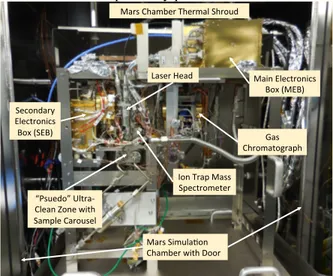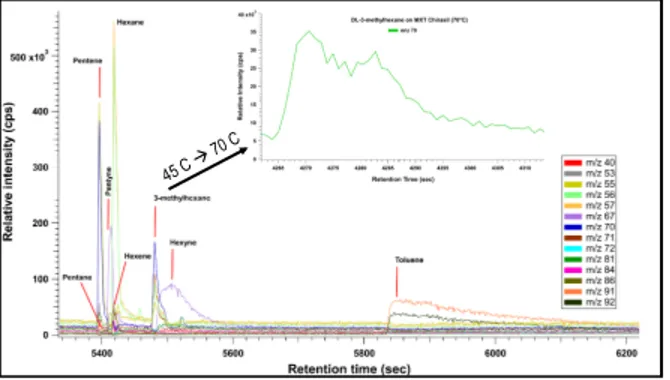HAL Id: hal-01815629
https://hal.archives-ouvertes.fr/hal-01815629
Submitted on 14 Jun 2018
HAL is a multi-disciplinary open access
archive for the deposit and dissemination of
sci-entific research documents, whether they are
pub-lished or not. The documents may come from
teaching and research institutions in France or
abroad, or from public or private research centers.
L’archive ouverte pluridisciplinaire HAL, est
destinée au dépôt et à la diffusion de documents
scientifiques de niveau recherche, publiés ou non,
émanant des établissements d’enseignement et de
recherche français ou étrangers, des laboratoires
publics ou privés.
Flight Integration and Test of the Mars Organic
Molecule Analyzer (MOMA)
William Brinckerhoff, Veronica Pinnick, Andrej Grubisic, Desmond Kaplan,
Ryan Danell, Friso van Amerom, Stéphanie Getty, Xiang Li, Ricardo Arevalo,
Caroline Freissinet, et al.
To cite this version:
William Brinckerhoff, Veronica Pinnick, Andrej Grubisic, Desmond Kaplan, Ryan Danell, et al.. Flight
Integration and Test of the Mars Organic Molecule Analyzer (MOMA). 49th LPSC Lunar and
Plan-etary Science Conference 2018, Mar 2018, Houston, United States. �hal-01815629�
FLIGHT INTEGRATION AND TEST OF THE MARS ORGANIC MOLECULE ANALYZER (MOMA).
William B. Brinckerhoff1, Veronica T. Pinnick1, Andrej Grubisic2, Desmond Kaplan3, Ryan M. Danell4, Friso H. W. van Amerom5, Stephanie A. Getty1, Xiang Li2, Ricardo D. Arevalo, Jr.6, Caroline Freissinet7, Zhiping Chu1, Marco Castillo2, Chris Johnson1, Cyril Szopa7, Fabien Stalport8, Arnaud Buch9, Tristan Allain8, Noel Grand8, Francois Rau-lin8, Walter Goetz10, Harald Steininger10, Fred Goesmann10, and the MOMA Team1-11, 1NASA Goddard Space Flight Center, 8800 Greenbelt Rd., Greenbelt, MD 20771; 2Center for Research and Exploration in Space Science & Technology (CRESST), University of Maryland, MD; 3KapScience LLC, Tewksbury, MA; 4Danell Consulting, Inc., Winterville, NC; 5Mini Mass Consulting, Hyattsville, MD; 6Dept. of Geology, Univ. of Maryland, College Park, MD; 7Laboratoire Atmosphères, Milieux, Observations Spatiales (LATMOS), Guyancourt, France; 8Laboratoire Interuniversitaire des Systèms Atmosphériques (LISA), Univ. Paris-Est, Créteil, France; 9Laboratoire de Génie des Procédés et Matériaux (LGPM), École Centrale Paris, Chatenay-Malabry, France; 10Max Planck Institut für Sonnen-systemforschung (MPS), Göttingen, Germany; 11Laser Zentrum Hannover e.V. (LZH), Hannover, Germany.
Introduction: The Mars Organic Molecule
Ana-lyzer (MOMA) investigation [1] on the 2020 ExoMars rover [2] will examine the molecular composition of crushed samples acquired from depths of up to two meters below the martian surface, where organics may have been protected from radiative and oxidative deg-radation [3,4]. MOMA combines pyrolysis-gas chro-matography/mass spectrometry (pyr-GCMS), both with and without chemical derivatization, and laser desorption mass spectrometry (LDMS), in coordina-tion with the other investigacoordina-tions in the rover’s Pasteur Payload, particularly the Raman [5] and MicrOmega [6] instruments. With its two modes, MOMA detects compounds over a wide range of molecular weight, volatility, and mineralological association.
Implementation of GCMS and LDMS Modes:
GCMS mode is operated analogously to the Sample Analysis at Mars (SAM) investigation on Curiosity. Samples are sealed into ovens and heated to 850 C. Analyte gases, entrained in He, flow through the GC system to the MS. The GC includes two cooled hydro-carbon traps (Tenax and Carbosieve) that are opened after major water evolution (above 100 C) but prior to organic thermodesorption (from ~300 C up to > 500 C). Trapped organics are injected onto one of four columns and eluted over a temperature ramp to the MS electron ionization (EI) source. GCMS analyzes com-pounds of high-to-moderate volatility (enthalpies of vaporization ΔHV ≤ 50 kJ mol-1) such as alkanes,
amines, and lighter carboxylic and amino acids and aromatic species. Derivatization agent present in some ovens enables detection of the higher ΔHV and polar
species over the full GCMS m/z range of 50-500 Da. In LDMS mode, molecules are desorbed and ion-ized directly from powder samples with a pulsed UV laser (266 nm, 1 ns duration) at Mars ambient pres-sures. Parent molecular cations, and their fragments, enter the MS through a fast aperture valve that closes after ions are trapped, permitting the ion trap pressure to reduce to <10-3 Torr where the detectors can be
op-erated. LDMS mode is designed to analyze compounds of moderate-to-low volatility (ΔHV≥ 40 kJ mol-1) such
as heavier carboxylic acids, aromatic species, chain-like compounds, and macromolecular organics. The pulsed LDMS mode is not strongly affected by the potentially oxidizing effects of heat-evolved perchlo-rates, simplifying analysis of nonvolatile organics [7].
Flight System Intergration and Test: All flight
models (MS, laser, electronics, pyrolysis, GC) have been individually tested, qualified, and delivered to the MOMA system integration and Mars thermal-vacuum facility at GSFC (Fig. 1), maintained under stringent contamination and planetary protection controls.
Fig. 1 Flight mass spectrometer and electronics assemblies
with laser and GC in Mars environment simulation chamber to match mechanical, thermal, pressure, and contamination conditions that MOMA will experience on the ExoMars rov-er. End-to-end “test-as-you-fly” operations over more than a dozen full thermal cycles verify all performance and reliabil-ity requirements as well as MOMA science calibration.
Testing of the GCMS mode on both engineering unit and flight instrumentation using calibration gases has demonstrated as-expected functional performance for resolution, acquisition rate, sensitivity, and
fragmenta-Main%Electronics% Box%(MEB)% Laser%Head% Ion%Trap%Mass% Spectrometer% Secondary% Electronics% Box%(SEB)% “Psuedo”%Ultra@ Clean%Zone%with% Sample%Carousel% Mars%Chamber%Thermal%Shroud% Mars%SimulaFon% Chamber%with%Door% Gas% Chromatograph% 2914.pdf 49th Lunar and Planetary Science Conference 2018 (LPI Contrib. No. 2083)
tion patterns. Analysis of a concentration series of vol-atile hydrocarbons was used to determine limits of detection for the mass spectrometer within expected MOMA sample volumes and analysis times. Benzene was readily detected at concentrations as low as 15 fmol s-1, or approximately 0.06 parts-per-billion by weight (ppbw) equivalent, depending on Mars pressure (which modulates effective gas split ratios), when sep-arated on a flight-level Restek CLP GC column. Sub-sequent testing of a broader mixture of gases using the MXT Chirasil column has provided intial data on GC separation for closely-spaced peaks under Mars condi-tions (Figure 2). The pentane/pentene/pentyne and hexane/hexane/hexyne triplets were individually re-solved by monitoring precise retention times combined with single ion count (SIC) data in the ITMS. The chi-ral compound D,L-3-methylhexane was clearly identi-fied; the separation of enantiomers was observed to increase dramatically with GC temperature (inset). The relatively high acquisition speed of the ion trap permits multiple full mass spectra across each GC peak, ena-bling accurate identification and quantification even in the presence of overlapping species.
Fig. 2 MOMA GCMS chromatograms as captured by MS
single ion chromatograms show separation and identification of hydrocarbons in He. Chiral D,L-3-methylhexane serves to test the GC enantiomeric separation over temperature.
The mass spectrometer including the flight model of the pulsed laser has now been tested, verifying ion transmission, sensitivity, resolution, and accuracy re-quirements over the mass range up to 1000 Da. A cali-bration target of solid CsI will be delivered to Mars with MOMA and used to track and correct any drift of m/z position or mass bias of sensitivity. Only trace-level (fmol) concentrations of selected organics are used to perform critical ground-test verification of the MOMA limit of detection for nonvolatile compounds in the FM. These have been demonstrated to leave zero residual background in the MS. Recent work has fo-cused on operating the LDMS mode with (i) automatic “gain control” of laser and inlet focusing parameters to achieve optimal ion trap loading per spectrum, and (ii)
stored waveform inverse Fourier transform (SWIFT) modes for ion isolation, concentration, and tandem MS (MS/MS) which permits structural analysis. Figure 3 demonstrates the successful application of SWIFT for MS/MS analysis of a phosphorous-bearing test target, which produces clusters with peak series of P (31 Da), P2 (62 Da), and P4 (124 Da) upon selective isolation and fragmentation. A substantial additional benefit of precise ion isolation is the enormous increase in signal-to-noise ratio for a narrow mass band due to suppres-sion of ion trap space charge effects during the analyti-cal ramp. Further work on increasingly complex and realistic analog target samples will enable incorpora-tion of automated LDMS protocols to maximize the benefits of neutral-loss identification of organics
Fig. 3 The SWIFT mode of LDMS operation isolates a
se-lected narrow m/z range around the P17 cluster, increasing SNR (middle) and enabling MS/MS identification (bottom).
Path Forward: Following final Mars
thermal-vacuum testing and data review, the MOMA instru-ment is scheduled for delivery to ExoMars rover inte-gration in March, 2018. It will be installed on the flight ultra-clean zone, containing the rover’s sample pro-cessing and distribution system (SPDS), under ex-tremely tight contamination and planetary protection constraints. Abbreviated end-to-end testing of both GCMS and LDMS modes to verify critical functionali-ty under rover-level Mars conditions will precede de-livery to higher levels of I&T and launch in 2020.
References:1. Goesmann, F. et al. (2017)
Astrobi-ology 17, 655-685. 2. Vago, J. et al. (2017) Astrobiolo-gy 17, 471-510. 3. Pavlov, A.A. et al. (2012) GRL 39,
L13202. 4. Quinn, R.C. et al. (2013) Astrobiology 13, 515-520. 5. Rull, F. et al. (2017) Astrobiology 17, 627-654. 6. Bibring, J-P. et al. (2017) Astrobiology 17, 621-626. 7. Li, X. et al. (2014) Astrobiology 15, 104-110.
Acknowledgments: MOMA is jointly supported
by DLR, CNES, and NASA. The MS development is supported by NASA’s Mars Exploration Program (Program Executive, David Lavery; Program Scientist, Mitch Schulte; Mission Manager, Peter Doms).
45 C ! 7 0 C Full Scan MS Isolation 8Da 124Da = P4 MS/MS (fragmentation) 62Da = P2 527Da = P17 cluster 2914.pdf 49th Lunar and Planetary Science Conference 2018 (LPI Contrib. No. 2083)

